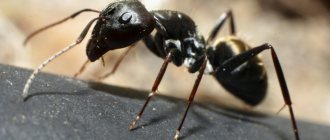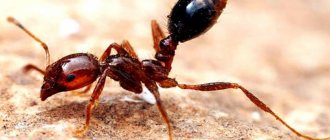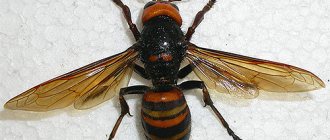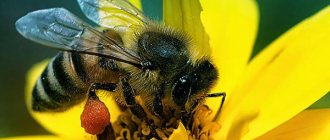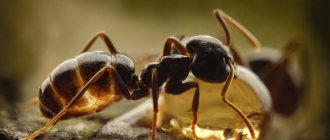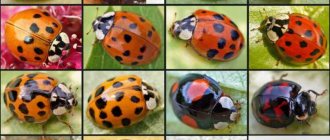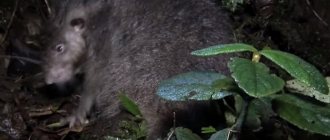At first glance, the anthill seems to be a disorderly pile of branches, pine needles, grass and earth. However, in fact, inside this unsightly heap a real city lives its life. Here everyone knows their place, everything is subject to a strict routine. These tiny insects, which do not have highly developed intelligence, but create anthills, nevertheless quickly capture any suitable territory and form numerous colonies. Let's figure out how the anthill works?
Article structure
- 1 How is the inside of an anthill arranged, what is its structure?
- 2 How does an ant colony work?
- 3 Life of ants in an anthill
- 4 Relationships and communication of ants
- 5 An anthill is not the best neighborhood
- 6 Life in an anthill - video
How is the inside of an anthill arranged, what is its structure?
Sectional diagram of the structure of an anthill with the designation of functional chambers.
Structure of an ant colony. Most often, dome-shaped anthills are found, but sometimes ants prefer to settle in rotten tree trunks or large old stumps. In regions with extremely hot climates (for example, deserts), insects build their homes exclusively underground.
The inside of an anthill looks different, but the structure of the allocation and organization of specialized chambers is characteristic of any nest of ants.
Indoor cameras can be divided into the following categories:
- “ solarium ” - a small chamber under the very dome of the anthill, insects bask in it in the warm season;
- “ wintering chamber ” - located below the soil level, in which the ants survive the cold, plunging into suspended animation;
- “royal chamber” or “ queen’s room ” - here is the queen who lays eggs;
- “grain barn” or “ granary ” - intended for storing grass and tree seeds;
- “kindergarten” or “ nursery ” - chambers in which eggs mature and ant larvae are born;
- “meat pantry” or “ refrigerator ” - they store the corpses of insects, worms and caterpillars.
- “cow barn” - where ants contain and raise aphids.
- " graveyard " is a place where waste and deceased individuals are found. It is significantly removed from the anthill, since the ants understand that corpses and waste are a source of disease and infection;
Each sexually mature insect has a clear idea of the location of the chambers. An increase in the anthill leads to the expansion of existing chambers and the construction of new premises.
The depth of the anthill underground can reach up to 2 meters and has an organized complex structure. And the above-ground part can be from 30 cm to 2 m high. All this looks like a huge city.
The depth and structure of an ordinary anthill are amazing. The insides of this amazing structure consist of large fragments of branches. Between them there are many galleries leading to individual chambers, which is a rather complex device.
The height of the structure varies from 30 cm to 2 m, the underground part most often exceeds the above-ground area. The outer covering consists of small twigs, pine needles, grains of sand and reliably protects ants from dampness, wind and cold. The structure of the underground anthill of the garden ant is similar to the forest one, but on the surface it is only a small sandy mound.
Here are a few photos of what a large forest anthill looks like:
The underground part, as a rule, is comparable, and often exceeds the above-ground part in size. In places where there are large reserves of resources for ants (water, cereals, insects of other species), dwellings can reach gigantic sizes. In some cases, the population of a colony can exceed, imagine, 1.5 million individuals.
The anthill is arranged in an interesting way: up to a third of the working ants continuously move needles and branches! Why are they doing this?
The anthill is designed in such a way that a positive temperature (26-29 degrees Celsius) is constantly maintained inside, which is very important for ants. For this purpose, pine needles and branches from the lower layer of coating are transferred to the surface, ventilated and dried. This process is continuous, and approximately a third of the worker ants participate in it. Thanks to their efforts, favorable conditions are created for the development of larvae and the preservation of food supplies.
Stage 4: External Intervention
Our anthill is degrading more and more rapidly. A narcotic substance secreted by parasitic beetles, Lomechus, caused the appearance of down ants (pseudoergates) in the nest, which are not capable of procreation or active socially useful activities. There are more and more Lomehus and pseudoergates in the anthill. This means more and more parasites and less and less food. A little more, and the degradation process will become irreversible.
If the anthill were more numerous, the process could last for many years: “drag dealer” beetles reproduce more slowly than ants, they simply would not keep up with population growth, affecting only some sectors of the nest. But our anthill is small, so only external intervention—cleaning—can save it.
We should hurry up. Cleaning the anthill from Lomechus is possible until the down ants have had time to breed in large numbers. For cleaning we will need two containers (ordinary buckets with tight lids will do), a large piece of polyethylene measuring 1.5 by 1.5 meters, rubber gloves and a spatula. We find the healthiest sector of the anthill, cut it off with a spatula, like a piece of pie, quickly move it into a bucket - along with the ants, larvae, eggs and nesting material - and tightly close the lid. Then pour the contents of the bucket with ants in small portions onto polyethylene and carefully sort through them. The same way one sorts out cereals for porridge: we simply move healthy ants and nesting material from one pile to another. We catch “drug dealer” beetles and hopelessly sick down ants (pseudoergates), crush them and throw them away. We immediately move each cleaned portion of the anthill into the second bucket.
Lomehus are easy to recognize - they are very different from ants in size (2-3 times smaller) and color (bright brown). It is more difficult with pseudoergates - they are almost no different from healthy ants. But their behavior gives them away. Healthy individuals immediately begin to perform their functions: foragers collect building material scattered on polyethylene, nesting ants show concern for larvae and eggs, guard ants bite the offender. Only the pseudo-ergates loiter idle.
The entire cleaning procedure took us a little over an hour. Dead Lomechus and Pseudoergates were placed in one faceted glass - we dissected some of them for scientific purposes. During the cleaning, we came across one queen female, but even if they all remained in the infected nest, there was no need to worry: it is in August that the ants swarm - the mating season. Winged females and males appear in the nest, they actively mate in the air and there is no shortage of fertilized females. Now all that remains is to find a place for the surviving anthill.
And no one will help those who remained in the nest affected by the Lomehuzas.
How does an ant colony work?
The social hierarchy within an ant colony is often compared to the structure of a bee hive. These two species are similar in many ways, but the behavior of ants is still much more complex. Just like in human society, these insects have a strict division into classes. The anthill is designed in such a way that each mature individual has its own purpose.
Depending on a set of certain qualities, each insect is assigned to one or another social post. In this case, the personal qualities of the individual are taken into account - excessive aggressiveness, keen sense of smell, reaction speed. The hierarchy of any anthill contains the following categories of individuals:
- invaders - the most aggressive group in the anthill, attacks neighboring colonies and seizes territories;
- orderlies - isolate sick and wounded ants, if necessary, play the role of surgeons - the damaged limb is often amputated (gnawed off);
- builders are one of the largest social groups. They are engaged in repairs of premises and the external covering of the home. Throughout their life, they dig new tunnels, transport needles and twigs, and maintain the microclimate inside the anthill;
- nannies - take care of the offspring, from the appearance of the egg to the adulthood of the individual. They are constantly near the larvae, turn them over, control the process of hatching from eggs and feed the growing offspring;
- guards - are engaged in guarding the entrances and exits of the anthill; in the event of an attack, they attack the enemy and do not allow him to get inside the dwelling. Among this category there are the most losses; attacks on neighbors are common for neighboring colonies. In addition, birds and some animals like to feast on ants, and the guards never leave their posts, protecting the entrance to the last.
- foragers . The largest group in the colony. Their mission is to obtain food for the entire anthill. Every day, miners go in search of food - grass seeds, dead and weakened insects, fruits and berries. If one ant finds a large insect (caterpillar, beetle), then with the help of special signals it communicates with its fellow tribesmen, “telling” about the prey. With their combined efforts, insects can even drag a dead rodent. Attacks often occur on weakened or wounded bees, worms, and mice. From numerous bites, the victim dies and becomes food for the colony;
- shepherds . Another amazing feature of these insects is that they have peculiar pets. Herbal aphids feed on plants, and the liquid released in the process - honeydew - is collected by ants. This liquid is a waste product of aphids, has a sweetish taste and serves as a kind of delicacy for insects. The carbohydrates contained in honeydew provide the ants with energy. Therefore, aphids are collected into peculiar “herds” and protected in every possible way (for example, from theft by ants from neighboring colonies). To increase the amount of honeydew, shepherds tickle the bellies of their cows, stimulating the production of the valuable substance;
- carriers - work together with shepherds, their main task is to carry honeydew into special chambers. If necessary, engage in battle with the invaders;
- storekeepers - responsible for maintaining supplies inside the cells. They monitor the maintenance of temperature conditions and the safety of supplies. The life of the colony during the winter months depends on them, since proper conservation of food resources ensures the prosperity of the anthill;
Depending on the habitat, special “professions” appear. For example, leaf-cutter ants living in forests collect leaves from certain trees and plants. Afterwards they are transferred to the anthill, twisted in a special way and used to grow mushrooms, which are one of the main products in their diet.
Interesting fact: in some species, the profession is genetically predetermined, which is reflected in the structure of the ant’s body. And in other species, the profession is acquired by individuals gradually and they are able to replace each other’s functions if necessary.
Physiological features
The body structure of these insects is divided into three parts, covered with a chitinous shell: the head, as well as the chest and abdomen connected by a thin waist. The eyes, which consist of many lenses, distinguish movement, but do not produce a clear image. Ants move with the help of six thin legs with claws at the ends, which allow the insect to climb upward.
The antennae, segmented, are located on the head. These are organs of touch that not only detect odors, but also feel the vibration of the soil and the movement of air currents. The structural features of the insect and the size of the ants depend on their species, as well as their status in the colony. On average it ranges from 1 mm to 3 cm.
The largest individuals in some species are females, in others their size is no larger than the size of working individuals. Females have wings that fall off after the mating season. The colors of ants can vary from black, red, yellow and brown to unusual green or bluish. Ants are difficult to classify, since twin species and numerous hybrids are common in nature. Only specialists can distinguish them by appearance.
Life of ants in an anthill
Each ant colony, regardless of species, has one or more queens. This is a large, sexually mature individual; the characteristic difference is its large transparent wings. They are necessary for searching for males; immediately after successful fertilization, the need for them disappears and they disappear.
The lifespan of a queen is from 3 to 6 years, which is almost twice as long as that of an ordinary worker. There are cases where the queen lived up to 20 years, while insects live longer in regions with temperate climates. Male drones live the shortest, their lifespan is no more than a month. After fertilization of the uterus, they are killed as unnecessary. (Learn more about how long ants live)
The fertilized queen lays eggs in the lowest and most extensive chamber of the anthill, located deep underground. And the size of an anthill underground can reach up to two meters! This is necessary to protect the offspring from predators, temperature changes and other dangerous factors.
The queen's lifestyle is different for each species. Thus, wild forest ants have several hundred young unfertilized females in their colony. After mating, females lay clutches throughout the forest, and new colonies form next to them.
The ants of a colony located next to a person always contain several dozen male drones. The overwhelming majority of the population consists of underdeveloped females. In a small colony there is only one queen, who carries out procreation.
If the conditions in a house or apartment are favorable (warm, damp, unsanitary), then the number of ants quickly increases. In this case, several new queens appear that are capable of reproduction, which enhances the development possibilities of the colony. These females do not form new colonies, but remain part of the existing one. Of course, as the number of queens increases, the spread of ants around the house accelerates.
Installation of information signs
My family and I really love nature, walking in the park and going to the forest in the suburbs of Noginsk, picking mushrooms and just riding a bike.
Unfortunately, based on the results of such walks, I had to come to the conclusion that the farther the forest is from the city and people, the more beautiful and lively it is.
Near roads, holiday villages, cities, the forest is different. It is darker, damper, there are more fallen trees, there is garbage, traces of fires. And there are no animals visible at all, few forest birds.
There are also almost no anthills near the city.
City park - no anthills found.
Forest "on Volkhonka" - no anthills found.
Forest in the vicinity of the Avtomobilist stadium - no anthills were found.
"Hazel" - no anthills found.
Forest in the area - no anthills found.
The closest place to the city where anthills were found is in the area of the street. Collective village Babenki.
My teacher, Zhanna Nikolaevna Goryainova, suggested making signs with information that ants need to be protected (see Figure 13), and installing these signs in the places where we find anthills.
Figure 13. Layout of a sign with information about the benefits and need to protect ants.
As a result, during October-November 2015, we installed three signs in the area of the villages of Babenki, Mamontovo and Timkovo, Noginsk district (see Figure 14-17).
Figure 14. Map of the location of installed signs in the suburbs of the city of Noginsk, Moscow region.
Figure 15. Photo of plate No. 3 (08.10.15, GPS coordinates 55°52'43.0″N 38°29'53.5″E)
Figure 16. Photo of plate No. 1 (11/08/15, GPS coordinates 55°55'8.19″N 38°36'10.17″E)
Figure 17. Photo of plate No. 2 (11/08/15, GPS coordinates 55°55'32.28″N 38°33'44.5″E)
We are not going to stop there. Seven more signs have already been prepared, which will be installed in the forests of the Noginsk region in 2016.
I hope that these signs will remind people that they need to take care of the surrounding nature, not destroy anthills, and will make them think about the fact that around us in the forest there is life in full swing, which we do not see, but without which the world around us will be completely different.
Relationships and communication of ants
Among these small insects there is a peculiar struggle for power. For example, in colonies of red ants, cases of capture of settlements of another species were observed. The queen queen finds a colony of black or forest relatives weakened due to an attack and takes the place of the dead queen. She then lays eggs, and when the red ants hatch from them, they actually enslave the colony of another species.
The opposite situation also occurs. During an attack from one anthill to another, the soldiers steal the eggs of their opponents and take them to themselves. After hatching, the insects become servants and work all their lives for the benefit of someone else’s colony. The life of many species of tropical ants is built on this principle: for example, Amazon ants are exclusively engaged in attacks on neighbors and capturing larvae; all the hard work inside their home and maintenance of life occurs only at the expense of slaves.
In nature, the opposite situation can be observed, when working individuals of neighboring anthills establish contact and exchange food. This is a kind of message to neighbors about peace and a proposal to unite into one colony.
This is how interesting the anthill is designed - it is an amazing structure with a complex organization, reminiscent of a big city. How much time and labor does it cost these tiny insects to rebuild an ant colony, the above-ground part of which is at every moment under threat from predators or natural phenomena.
Ants: general characteristics
Ants are insects that live in almost all corners of our planet, with the exception of Greenland and Antarctica, as well as some oceanic islands. They populated not only steppes and forests, but also deserts. There are 13.5 thousand species of ants, 300 of them are common in our country.
Ants belong to the order Hymenoptera, phylum of arthropods, class of insects, family of ants. These are social insects, clearly divided into three castes: males, females, and workers. These little hardworking creatures cannot live alone, so they always create colonies.
An anthill is not the best neighborhood
Of course, forest ants bring invaluable benefits - destruction of carrion, maintaining the population of birds and small animals. It is categorically forbidden to destroy the housing of forest orderlies, but to tolerate being next to each other in your own house or apartment is unacceptable. That is why, at the first sign of the appearance of these insects in or near the house, you need to take measures - getting rid of trash, using traditional methods of control. If the moment is missed and the colony has reached an impressive size, the best solution would be to contact specialists.
Insect development
These representatives of the insect world have a full cycle of transformation and, accordingly, go through 4 stages of development.
- The queen lays a huge number of eggs - this is the first stage.
- When the incubation period ends, a larva emerges from the egg, which looks nothing like an adult, but rather looks like a worm. The main task of this stage of ant development is active nutrition and rapid growth.
- The next step is the pupa. The larva stops feeding and, under optimal conditions, pupates in about two weeks.
- The imago (adult insect) emerges from the cocoon on about the twelfth day. Young ants are practically no different from their older counterparts, only they are small in size and lighter in color.
This is the development scheme for these inhabitants of the colony; the entire process described takes no more than a month.
The life span and characteristics of each representative of an ant colony largely depend on what functions it performs. Thus, the queen is always alone, it is she who reproduces working individuals and is distinguished by longevity. Males play only one role - fertilization. Having fulfilled their functions, they become unnecessary to the colony and die. Finally, working individuals are, of course, very important, but there are always a large number of them, and therefore their life span is short.
Career ladder
Typically, a worker ant changes several professions during its life. The young are busy inside the nest: they look after the female (“retinue”), children, that is, eggs and larvae (“nannies”), and older workers (“grooms”), clean and repair underground chambers and passages (“repairmen”), store water (“barrel ants”).
After working for 1–3 years and gaining experience and qualifications, the ants are transferred to the reserve, where they can rest a little and allow new generations of young workers to take care of themselves. Approximately a third of the “proletariat” is in reserve, but they must be constantly prepared to deal with the consequences of accidents and natural disasters.
Question answer
How to get rid of ants in garden beds and greenhouses?
The ranks of “employees” working outside the nest are also replenished from the reserve - builders, foragers (scouts, hunters or food gatherers), water carriers, orderlies, guards, and experienced veteran observers.
Amazing Unity
Having become familiar with the structure of the anthill and the description of its inhabitants, the reader will be interested to learn about their unity. The entire population acts as a single organism (this is already known to many).
But as additional information, it is worth giving a clear example. Experts have seen more than once how ants fight fires that have engulfed their homes. They simply put out the fire using formic acid secreted by the worker ants. Each is capable of releasing only a meager fraction of a milligram - fire cannot handle such a blow. However, when tens and hundreds of thousands of individuals come into play at the same time, a small flame cannot resist - it really gets knocked down, goes out, without causing damage to the anthill that it could not survive.
Some interesting facts
- Some of the species of these arthropods can remain under water without access to air for 4 days, as if in a preserved state. Once removed from the liquid, they come to life again and continue to exist.
- The ant's legs (there are 6 of them, and each has 3 joints) are very strong. They seem to be designed by nature for heavy work and moving loads. By the way, if this insect were as tall as humans, then, in proportion to its physical characteristics, it could run at speeds of up to 60 kilometers per hour and lift loads of one and a half tons!
- Ants, according to some researchers, have a collective intelligence, and the total number of their brain cells (for a single anthill) is comparable to the number of the same cells in humans.
Views:
Types of insects
The lifespan of the inhabitants of a colony is largely determined by their species.
- Pharaoh ants: workers - no more than 60 days, producers - 20 days.
- Tropical bulldog ants: workers - up to 5 years, queens - up to 20 years.
- The red wood ant is genetically predisposed to a five-year existence, but in nature it dies more often, becoming a victim of a bird of prey or an unfavorable environmental factor.
- Black garden ants can theoretically celebrate their third birthday, but in nature their lifespan is reduced to a year.
As we see, in real conditions, not all insects manage to live the genetically programmed number of years.
What do the dreamer’s behavior promise?
The behavior of the owner of the vision can radically change the interpretation of night vision:
- Unless a person imagined that he was hiding behind a doorway, this speaks of his lack of confidence in himself and his abilities. He is afraid of his competitors alias rivals, because he does not want to ruin his reputation. Whatever you say, such behavior will not solve the problems that have arisen. Needs to be demonstrated. Ant. hide your strength of character in order to achieve your goals and not pay attention to the machinations of ill-wishers and envious people.
- If the dreamer holds the door and does not let go of it, the dream characterizes him as a closed person. He is afraid to open up to other people. However, this can lead to a person living completely alone, deprived of the joy of communicating with friends, colleagues and family.
- If the dreamer is looking for a doorway in night vision, then this promises to enter a dead end situation, from which a person will not be able to get out alone. It will be necessary to turn to loved ones for help. Another wheel in the dream cart warns a person that it is worth holding off on opening his condition, as there is a risk of going bankrupt and losing all his deposited money.
- Painting a doorway a new color means discord in the family due to the dreamer’s unreasonable jealousy. This can lead to separation from a loved one.
- Washing the doors in your home means a pleasant meeting with relatives from afar. Another dream commentary suggests that the sleeping person is the master of his own destiny, and the beloved can independently take on all urgent matters.
- Closing the gate behind one of the strangers is an attempt to protect yours by taking seven times from the evil intentions of envious people and ill-wishers.
To see a door with a lock, but not be able to open it, says the book that the dreamer is afraid of something. This phobia prevents a person from making important decisions. If someone helped open the door, this is a sign that the owner of the vision needs the moral support of loved ones. If a young man dreams that he opens a doorway with a key, then he will be able to win the favor of a girl he likes. Another significance of the dream is that a man will be able to solve problems at work thanks to his extraordinary abilities.
If the dreamer happened to lock the door, then this is a warning about the book that he will soon need to compete with strong and dangerous rivals. In order to resolve the situation peacefully, it will be necessary to make a lot of efforts. Locking the door means a quick wedding. If in a dream you happened to close the door with a lock, then this is a warning for the dreamer. You need to rest and gain strength. Otherwise, the possibility of developing a serious illness is excluded. If a woman saw in a dream how she locks the door from the inside, this means that she is afraid of an unwanted pregnancy. For males, such a nightly phenomenon predicts a scandal with his girlfriend, one that could lead to the separation of a couple in love.
If a girl dreamed that some unknown man was trying to break down the door, the vision was that she had heard of the presence in her close circle of a man who planned to ruin the dreamer’s reputation. Someone wants to do this in order to take revenge on a woman because she once rejected his feelings and hurt a man’s ambition. If the dreamer breaks a doorway, then this symbolizes his desire to free himself from what weighs him down. This could be a friendship with a person who once betrayed the dreamer, or a romantic relationship that has lost its former passion. The time has come for more active action in this direction.
Blunting it into the bell means unexpected news from afar. Another meaning is that soon there will be a congress with unpleasant people from the dreamer’s past.
Knocking down a door means enormous success awaits a person. To achieve it you will have to work hard and hard.
